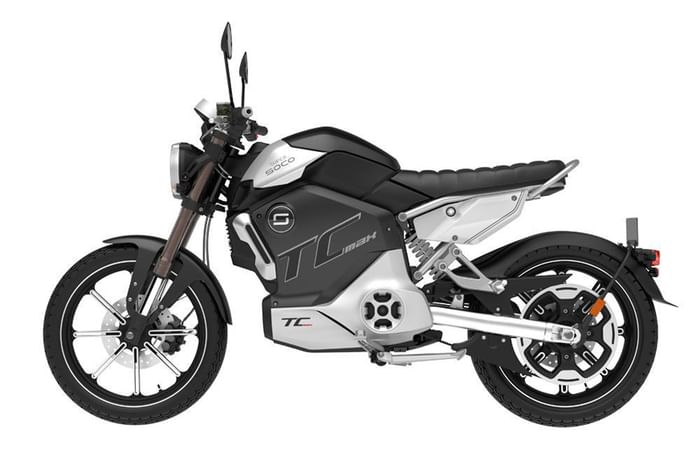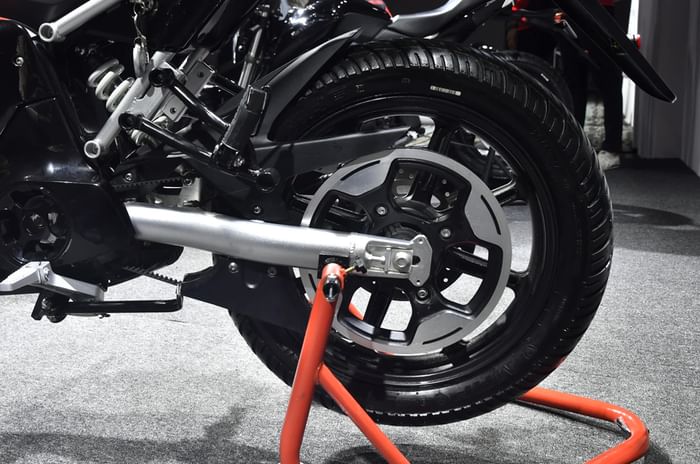It shares its platform with the Chinese Super Soco TC Max
Soco is a Chinese brand headquartered in Shanghai that sells small electric scooters and bikes in numerous markets overseas, including Europe and Australia. At first glance, the Revolt RV 400 looks almost identical to the Super Soco TS1200R, especially in terms of the headlamp design, slim bodywork and overall stance. A closer look with the images side-by-side will reveal that almost every body panel has been redesigned by Revolt for the RV 400 and the only common features we can spot are the LCD digital display, LED tail lamp and the full-LED headlamp. Revolt tells us that while the headlamp looks very similar, they’ve reworked its internals and that this unit is more powerful.

The issue is that TS1200R offers very limited range and performance as compared to what the RV 400 claims. Most of all, the Super Soco TS1200R has a rear-wheel-hub-mounted motor whereas the Revolt uses a frame-mounted motor that powers the rear wheel via belt-drive. Clearly these two are not the same under the skin. A deeper dive into the internet to find some answers reveals another Super Soco e-bike which was unveiled at EICMA 2018. This one was called the TC Max and has specifications much more in line with what we see on the Revolt RV 400.

The Super Soco TC Max has the same exposed belt drive as well as the longer swingarm that’s seen on the Revolt RV 400. The Revolt’s removable Li-ion battery and keyless-start ‘Power’ button also appear to be straight lifts from the TC Max.
Expect 125cc levels of performance
Revolt hasn’t shared specifications yet, but their estimated top speed of 85kph is very close to the 93.3kph quoted by Soco. Interestingly, the RV 400’s ARAI quoted range of 156km is much higher than the Soco’s claimed range of 96.5km. However, Soco claims this figure has been recorded at a constant speed of 48kph while it is likely that the ARAI figure was achieved the low-performance Eco mode. Its real-world range in City and Sport modes is still in question.

Going by the similarities in performance, it is highly likely that the Revolt motor will quote the same 3.5kW rating (max power 5kW) and that the max torque at the rear wheel will be similar to Soco’s 180Nm. Mind you, this is calculated after the reduction ratio and is very different to the max torque produced at the motor – a number which isn’t quoted on the Soco website.
I had the opportunity to briefly ride one of the Revolt prototypes a couple of months back and the pace on offer seemed similar to a 125cc machine, or the Ather 450. In case you’re wondering, the RV 400 seats you like a motorcycle, but you ride it just like a scooter. There are no gears and it is basic twist-and-go, along with a handlebar-mounted rear-brake lever.
It’s ‘AI enabled’ and stuffed with features
‘AI-enabled’ is a heavy term, but it basically means that the scooter is always collecting and processing riding data that it then uses to improve the user experience. To do so, it uses a 4G SIM card that comes with the scooter and we’re unsure whether there will be any separate charges for this. We’re told that the AI will enable real-time motorcycle and battery diagnostics and can even send an alert if it thinks something is about to fail.

Another function of the AI system is that it will monitor your riding style, which, in turn, will have an impact on insurance premiums. If it deems you to be a ‘good rider’ your premiums might come down. If it thinks otherwise, they could go up. Let us know how comfortable you are with this in the comments below.
Armed with a mobile app, there’s a heap of functionality available, including the ability to remotely start the bike via the app. We’re not sure why you’d want to do this though, because the RV 400 also comes with keyless-start, which lets you keep the key in your pocket and start the bike by pressing the ‘Power’ button that resides behind the handlebar.
The Revolt RV 400 also offers a geofencing feature that allows you to set a radius on the map in the phone app, beyond which the bike cannot cross – great for parents, not so much for the kids. What youngsters will like, however, is the ability to select from pre-recorded engine sounds and have them played back via a speaker on the bike. The idea is that the sound will be produced based on the vehicle speed and load on the motor, so as to keep it fairly authentic. There are four pre-recorded sounds available in the app (including an in-line-four cylinder!) but users can download more and even create their own. I can’t wait to see the results.
Aside from this, there’s the usual trip, battery level, available range and rider data available, which is similar to what we first saw with Ather. You can also share the bike’s location and there is a ‘find my bike’ feature that uses the map function in the app. What we haven’t come across so far is any mention of a navigation function.
There’s a comprehensive plan for charging support
Keeping the batteries charged is the biggest concern with the shift to electric mobility and Revolt has taken the most comprehensive approach to this that we have seen till date. First, there’s the basic home charging (needs a 15A socket), which Revolt says will take about 4hr for a full charge. The second solution comes in the form of a removable battery pack, but we understand that it weighs a substantial 15kg, and the thought of hauling that around on a daily basis isn’t very comforting.
The third and fourth solutions are where things get interesting. Revolt says that it will have mobile battery stations in every city it is present in. Basically, you use the app to find where the closest one is and either navigate in that direction, or call for the mobile van to your location to swap your battery out for a fully charged one. Finally, Revolt says you can even have a fully charged battery delivered to your doorstep if the need arises, which has got to be convenient.

At the moment, we don’t know how much these services will cost, but given the fact that the batteries will now be floating through the ecosystem, we assume there has to be some kind of battery leasing system. Revolt may even be planning something similar to 22 KYMCO where you buy the vehicle without the battery and pay for some kind of subscription scheme to lease the batteries and avail of all the above services.
It will be priced well
In addition to keeping the full specifications under wraps, the company is also being shy about the price. One senior official hinted to us that the pricing will be very competitive, and that’s easy to expect, considering the old Micromax (Revolt was formed by Rahul Sharma, the co-founder of Micromax) mantra of competitive pricing.
The company has set-up a plant in Manesar where these bikes will be manufactured and there’s already a fair bit of localisation on the machines that we saw at the unveil. The wheels and bodywork are made in India, the tyres are by MRF and the brakes and suspension will supposedly soon be localised as well. For now, the frame, powertrain, batteries and battery management system all come from China, and it is likely to stay that way, although Revolt may localise the frame further down the road.
With this in mind, I think it’s safe to expect a price somewhere along the lines of the Ather scooters, but I won’t be shocked if Revolt manages a sub-Rs 1 lakh price point – especially if the battery is not included in the buy-in cost. We’ll know soon enough, with its launch slated for next month.
Revolt will begin sales in Delhi, with Pune following soon after and the company plans to be in Bengaluru, Hyderabad, Nagpur, Ahmedabad and Chennai within the next few months. Sales will happen via dedicated experience showrooms and the bike can be bought online through Amazon as well. If you think you already know all you need to and want to get your hands on one as soon as possible, pre-bookings open on 25 June for the sum of Rs 1,000.































